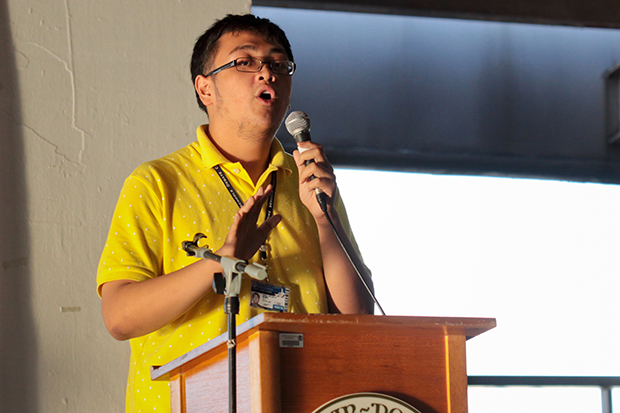“I REALLY don’t expect huge success if you measure success through the immensity of efforts lifted from the House.”
This is what the Assistant to the Sanggunian President for Special Projects Astrid Ocampo said about the difficulties of institutionalizing the House of Representatives (HOR) in an interview with The GUIDON last September 15.
Ocampo is in charge of the HOR initiative of the Sanggunian.
“I have to be honest—it’s very difficult handling such [a] task because it’s not in the representatives’ second nature to work on such thing,” she said.
The HOR is an avenue for block and course representatives to legislate policies with regard to various social issues.
Reassessment of the HOR
Ocampo believes that the HOR should already be “full blown” by next semester, given the need to “reassess” the body as a whole.
At present, an official description of the HOR has yet to be created.
However, in the June 2013 issue of The GUIDON, Sanggunian President Dan Remo said that one of the significant tasks of the HOR will be to assist the Sanggunian Central Board (CB) in crafting policies and in creating the official statements of the Sanggunian with regard to various social concerns.
Remo added that he intends to use the HOR as “a method to be able to advise the president and the Sanggunian as a whole as to what should be the direction of the institution.”
Ocampo said that there have been two efforts to put up the HOR in the past. One was during the administration of former Sanggunian President Drew Copuyoc in school year 2011 to 2012. The HOR was also assembled last year, during the term of former Sanggunian President Gio Alejo.
Ocampo said that the HOR was reinstated this year to once again attempt to extend the functions of the block and course representatives.
The current role of the block and course representatives is to examine the administrative and other services that the Ateneo students experience on a daily basis in order to address their concerns.
Ocampo further said that the reinstatement of the HOR is an attempt by the current Sanggunian administration to further empower the course and block representatives so as to address the “lack of connection” to its constituents.
“These representatives are the closest we have to reaching out to the constituents. That’s why it’s crucial to optimize their functions,” Ocampo said.
Furthermore, Sanggunian Constitutional Convention (Con-Con) Head Nick Lucero said that the HOR was created “to improve consultations with the constituents.”
The Con-Con is a unit that directly forwards proposed Sanggunian constitutional amendments to the plebiscite.
Lucero said that proper implementation of the HOR can help the Sanggunian bridge the gap between the administration, external networks and students of the Ateneo.
However, Ocampo said that the biggest challenge the Sanggunian is currently facing is getting the block and course representatives to realize how important the HOR is.
On limits and difficulties
Ocampo aims to make the HOR fully effective. She explained that the success of the HOR could be properly gauged once the course and block representatives have “encultured” their added legislative function.
She said that the HOR meetings would be held twice a month starting next semester so that the representatives would grow accustomed to their additional roles.
Lucero, meanwhile, said he is concerned that there is no practical framework for the implementation of the HOR.
“In the past few HOR sessions, discourse has often been manipulated by interested parties, leaving little room for the opinion of other representatives due to insufficient time and poor management of the floor,” he said.
However, Ocampo believes that the key to making the HOR significant is through politicization.
“That (politicization) is to think the way a government official does,” she explained.
Lucero said that the provisions for the HOR should be drafted into the constitution only when the Sanggunian is able to find a way to accommodate the over 200 representatives and train them to represent their respective constituencies properly.
“Until then, the HOR should keep trying to find more feasible frameworks for executing this initiative,” Lucero added.
Parallel to PH Congress
Ocampo explained that the HOR would follow the system currently being implemented in the Philippine Congress.
The positions to be included in the initiative are the following: Speaker of the house, deputy speakers per school, secretary-general and the sergeant-at-arms.
The course and block representatives will have committees similar to those of the CB, such as the Administrative Services Committee, Formative Services Committee and Academic Affairs Committee, among others.
“They (representatives) can act as close associates and consultative body of their Central Board counterparts,” Ocampo said.
She added that the course and block representatives also have the option to create special committees for the HOR, including committees for scholars and the lesbian, gay, bisexual and transgender community in the Ateneo.
“They can [create special committees] so that these sectors shall also be equally heard and represented,” Ocampo said.
She explained that the representatives will “e-mail their motions or proposals to the secretary-general at least a week before the House assembly.”
The secretary-general will then list the proposals on their online group page for the House to decide on what will be part of the agenda.
“Whatever shall be included in the agenda shall be discussed during the session and whatever comes out will be polished by the House Speaker,” she said.
The results will then be forwarded to Sanggunian President Remo for discussion.
“Dan Remo acts as our bridge to making sure the HOR gets to the Central Board,” she said.
Remo believes that the HOR will serve as an empowering institution.
“It is really a culture of empowering our representatives into the structure [of the HOR], giving them more responsibilities [and] opportunities to be able to engage the community,” Remo said.
He explained that the work of the HOR takes place even outside its official sessions.
“When they form their committees [and] when they engage in issues, that’s the spirit we’re trying to encompass in [the] HOR,” he said.







